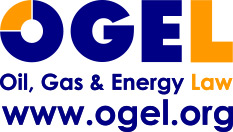Introduction - OGEL Special Issue on Natural Gas Pipeline Construction and Regulation
Article from: OGEL 5 (2019), in Editorial
Introduction
Converting primary energy to useable fuels for power and heat generation as well as transportation requires vast networks of infrastructure and value chains that are not easily replaced. Formidable commercial as well as engineering obstacles remain even where substitutions for hydrocarbon-based primary energy (currently comprising 85% of total global primary energy) with renewable sources (currently ~4% when nuclear and hydropower are stripped out) are readily available. In the case of natural gas (currently comprising 25% of total global primary energy and growing at 2.5% per annum), the value chains that link vast networks of infrastructure spanning upstream production to downstream utilization, often conclude with the generation and offtake of power.
Pipelines are key components in all mid-stream gas transportation systems and, until relatively recently, they comprised the entire network of transportation infrastructure from upstream production to downstream offtake. LNG now plays an increasingly important role in delinking the delivery of gas to specific markets only via fixed infrastructure and thus, enables a convergence of regional gas market pricing en route to global commodity pricing. Today, the majority of global inter-regional trade in natural gas consists of gas transported via high pressure pipeline (54.3%) whereas inter-regional trade in natural gas by LNG, while growing, currently stands at 45.7% of the global total.
Unsurprisingly, gas pipeline infrastructure is vastly uneven in its geographic distribution. For example, out of a total of 3.5 million kilometres of gas pipeline globally, 2.225 million kilometres (~64% of the global total) are located in the United States. Sub-Saharan Africa, on the other hand, holds approximately 4,100 kms of gas pipeline (1.5% of the global total). This disparity is also broadly consistent with the disparity in annual per capita GDP between the two regions -- $64,700 versus $1,700 respectively.
The US and the EU are the two most sophisticated jurisdictions for regulating gas markets. However, all 27 EU member countries together hold less than 5% of total global pipelines. EU consumers, moreover, pay nearly three times more for natural gas ($7.5 / Btu versus $2.7 / Btu) and more than twice as much as the American consumer for power (26.6c / kWh versus 12.7c / kWh). While this disparity in gas price is largely due to the greater abundance of indigenous gas production in the US, the disparity in gas transportation infrastructure density may also play a role. When we shift attention from gas per se to the cost of power, we can see that this may also be due to policy considerations that are much broader than consumer pricing. For example, the intensity of per capita primary energy consumption in the US is nearly twice as high as the EU reflecting material differences inter alia in energy efficiency policies. The EU is also susceptible to security of supply concerns, particularly vis a vis Russia, which are in part addressed through its diversity of supply policies.
Other large markets with high levels of primary energy utilization include China and India where each struggles to wean its cities off unsustainably high levels of emissions resulting particularly from coal-fired power generation. In the case of China, coal consumption alone accounts for 50.5% of total global consumption. To address the resulting pollution and GHG emissions, China is introducing new policies to stimulate greater production and consumption of natural gas. Unfortunately, China is woefully underserved in gas pipeline infrastructure especially when we consider that it is the most populous country in the world (18% of the global total) but it has only 5.7% of the world's gas pipelines.
Clearly, the careful formulation of public policy objectives to appropriately balance security of supply, consumer pricing, environmental (including GHG emissions and pollution reduction targets) and safety considerations must today be foremost in the minds of law and policy makers. Gas is playing a significant role as a useful 'transition fuel' given its relative abundance, cheap pricing, and the fact that it emits less than half of the GHG emissions relative to coal. This OGEL Special Issue on Natural Gas Pipeline and Construction is targeted to provide insights into the most current developments within the three most important gas pipeline markets (the US, China and the EU) as well as by providing insights into the regulation of pipeline development in frontier markets.
Mark Lewis and Kirk Morgan open this Special Issue by providing a comprehensive overview of the revolution in natural gas production that has led the US to emerge as the largest producer of gas in the world as well as a rising leader in global LNG export. This has been enabled, in part, by a remarkably efficient system for the regulation of gas pipeline and LNG export infrastructure. Prof Pollett next sets the scene for understanding the complex interface between jurisdictional and regulatory issues impacting the development, construction, operation and decommissioning of gas pipelines in the US. Finally, Deidre Duncan and Claire Ellis complete our review of the US gas pipeline market by looking at the significant emerging jurisprudence on GHG emissions in the context of FERC's NEPA process.
The issue next turns to a paper by Philip Andrews-Speed and Lixia Yao examining China's recent efforts to address efforts to introduce third party access into the bundled upstream and midstream gas markets now effectively controlled by an oligopoly of three NOCs. Regulatory efforts to break this oligopoly and enhance third party access will largely determine how quickly China is able to stimulate investment in its domestic natural gas production and badly needed new-build pipeline development.
The EU is a large regional gas consuming market supplied via multiple pipelines from the Russian Federation, Norway, the Maghreb and more recently, the Caspian. Concerns about imports from the Russian Federation have perhaps worried countries on the EU's eastern frontier than the larger European powers including Germany, France and Italy. Dirk Buschle and Kim Talus, the co-editor of this edition, look at these recent concerns through the prism of the recent European Court decision in the OPAL case which underscored the principle of solidarity in applying various EU energy-related laws. On the other hand, Moritz Wüstenberg looks at a recent a WTO Dispute Panel case where the Russian Federation successfully challenged the application of EU energy market liberalization principles. The key argument involved demonstrating how EU policies on Russian gas imports contravene WTO principles on quantitative restrictions.
Gokce Mete and Sergei Vinogradov, next examine recent developments in the financing of gas pipeline and LNG infrastructure and the role natural gas will play in the transition to a decarbonised market. On the other hand, Patrick Hebreard argues that there remains an important role for long-term commitments to underpin investment in new-build gas pipelines to the EU. Articles by Velislava Hristova and Stanislav Cherkezov, and André Brauner and Dr. Daniel Benrath, each look in detail at the interface of EU regulations and local law developments in the construction and operation of the IGB and gas pipelines within Germany respectively.
Finally, Merrick White, Nikhil Markanday and Kristian Whitaker examine the legal and contractual issues in the context of pipeline developments in emerging markets including TAPI, the West Natuna Sumatra Pipeline in Indonesia and TANAP. The various contractual mechanisms that may be applied to de-risk pipeline developments in largely unregulated frontier markets are considered.
There is a broad correlation between access to sustainable and affordable energy and per capita GDP. Fortunately, those regions that will experience the most explosive rates of population growth, e.g. sub-Saharan Africa, parts of the Middle East (e.g. Iraq) and Asia, in most instances, have adequate reserves of primary energy (including natural gas) to support healthy per capita GDP growth. Unfortunately, supplies are typically produced and exported rather than linked back into value chains, that can support growth in domestic power production and transportation infrastructure. Moreover, the absence of economically efficient means to store energy (currently priced at around $231 / kWh), will further impede efforts currently being made in developed OECD countries to limit growth in GHG emissions. The cost of releasing the Btu potential of a unit oil (or gas equivalent), when compared to alternative sources of primary energy, will require important policy decisions that will likely escalate the cost of energy significantly. Gas is, and will remain, an important source of primary energy for decades to come. Appropriate regulation of the sector, including regulation of the development, financing, construction and operation of gas pipelines will help to ensure that more of the world's population will have access to affordable and sustainable energy while technological solutions are identified and implemented.

